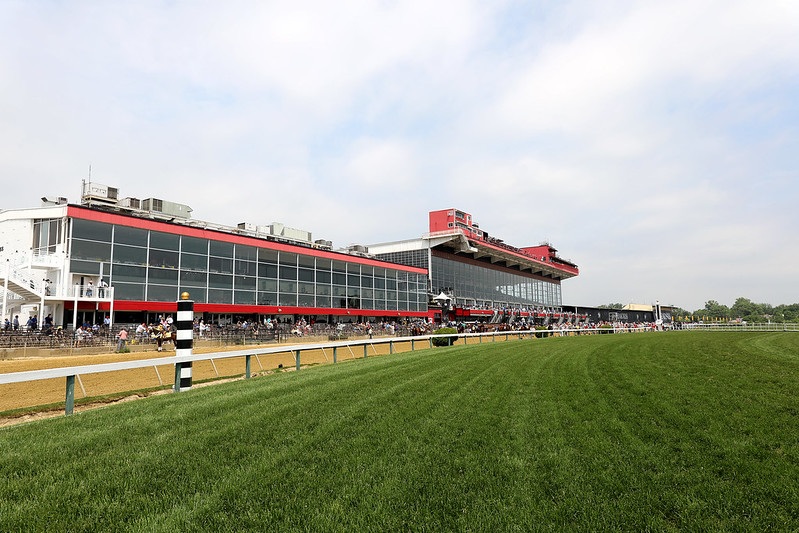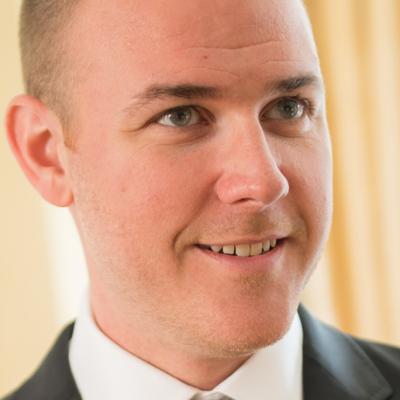
On any other third Saturday in May, the roads around Pimlico Race Course would have buzzed with a maze of colorful activity. In the mostly decrepit (but now to-be-refurbished) centuries-old grandstands, the scene would have been just as crowded and festive. Hats on heads. Black-Eyed Susans in hands. People in line at the betting window likely throwing away some money on a horse they know nearly nothing about. And, the infield would host, well, the usual equal parts entertaining and sloppy day-long party.
But the “Home of the Preakness,” the 150-year-old facility on the edge of the city’s northwest border in Park Heights, stood empty last Saturday.
At a little before 6 p.m., the traditional starting hour for what’s normally the second leg of horse racing’s Triple Crown, the only indication that something big was supposed to be going on was a small placard sign on the corner of Northern Parkway and Pimlico Road that read: “May 16, 2020: Preakness Day.”
It would have been a perfect afternoon and early evening for the fun, with sunny temperatures in the 80’s and not a cloud in the sky. Yet there wasn’t a horse, nor a casual fan or dressed-up, over-indulgent person in sight.
Like most everything else during this once-in-a-generation (hopefully) pandemic, plans changed for Baltimore’s longest-running, most tradition-rich gathering of the year when the contagious COVID-19 killer hit the U.S. in full force.
But thankfully, we now know what the new plan is. On Saturday, just around the same time the horses were supposed to be running in the 13th race of the day around the one-mile dirt oval at Pimlico, Maryland Gov. Larry Hogan announced a new date for the 145th Preakness Stakes: Saturday, October 3. “We look forward to celebrating with you soon,” Hogan said.
Due to the general reshuffling of life, including the sports calendar, the Preakness —if it goes on according to plan—will be the third race of the Triple Crown for the first time ever, giving it even more special meaning. The Belmont Stakes is scheduled for June 20 (without fans, organizers have already announced) and the Kentucky Derby is set for Labor Day weekend.
Given the unknown course of the coronavirus, whether the Derby and the Preakness allows fans into the race—or if people even want to go—remains to be seen. Much will likely be dictated by the virus’ spread over the next several months. It’s also important to note the Park Heights area has had the most cases of COVID-19 in the entire state.
InfieldFest—the annual rite of spring for many of Baltimore’s young adults—has already been cancelled by The Stronach Group, the race’s organizer. Ticketholders of any kind have been offered the option of a full refund or a transfer to the new October date or next spring, and more logistics are expected to be decided in about a month.
“There’s a lot of uncertainty still,” Belinda Stronach, the CEO of the company of her surname, said. “We’re trying to keep the tradition of the Triple Crown alive by going after the Kentucky Derby, but there’s still a bit of uncertainty in terms of whether we will be able to have fans in attendance. We’re going to do the best we can.”
Until then, we wait and watch, and hold out hope that Mayor Jack Young’s announcement on Wednesday—that all special events in the city would be canceled through August 31—doesn’t need to be extended into the fall.
Already we’re looking at no Fourth of July fireworks over the Inner Harbor or Artscape, another annual fair-weather tradition, and no other large public gatherings “until we can see some kind of downward turn,” in the COVID-19 cases and deaths, Young said at a press conference Wednesday.
In the meantime, the Orioles, if they play again this year (Major League Baseball owners and players are still arguing over money), will most certainly start doing so without fans at Camden Yards. And the Ravens—who knows? It depends on what the world looks like come fall.
But the news is not all sour, depending on your point of view.
Lost in the craziness of the pandemic shutdowns, on March 7, Hogan signed a bill into law that approved $375 million in state funding for a renovated multi-purpose Pimlico facility and upgraded year-round stables at Laurel Racetrack, a short drive south of the city. The money will come from programs that were already dedicated to the Maryland horse racing industry.
The legislation passed both houses of the Maryland General Assembly on the last day of a shortened session due to the virus. It was a compromise of sorts between the state and The Stronach Group, and was brokered by Alan Foreman, legal counsel for the Maryland Thoroughbred Horsemen’s Association; Alan Rifkin, legal counsel for the Maryland Jockey Club (which is owned by Stronachs); and Bill Cole, a consultant who previously served as President of the Baltimore Development Corp.
After years of uncertainty and despite what looked like a long-shot just a year ago, the Preakness is staying in Baltimore.
We have a vision for Pimlico’s future—and it doesn’t include any empty seats.
